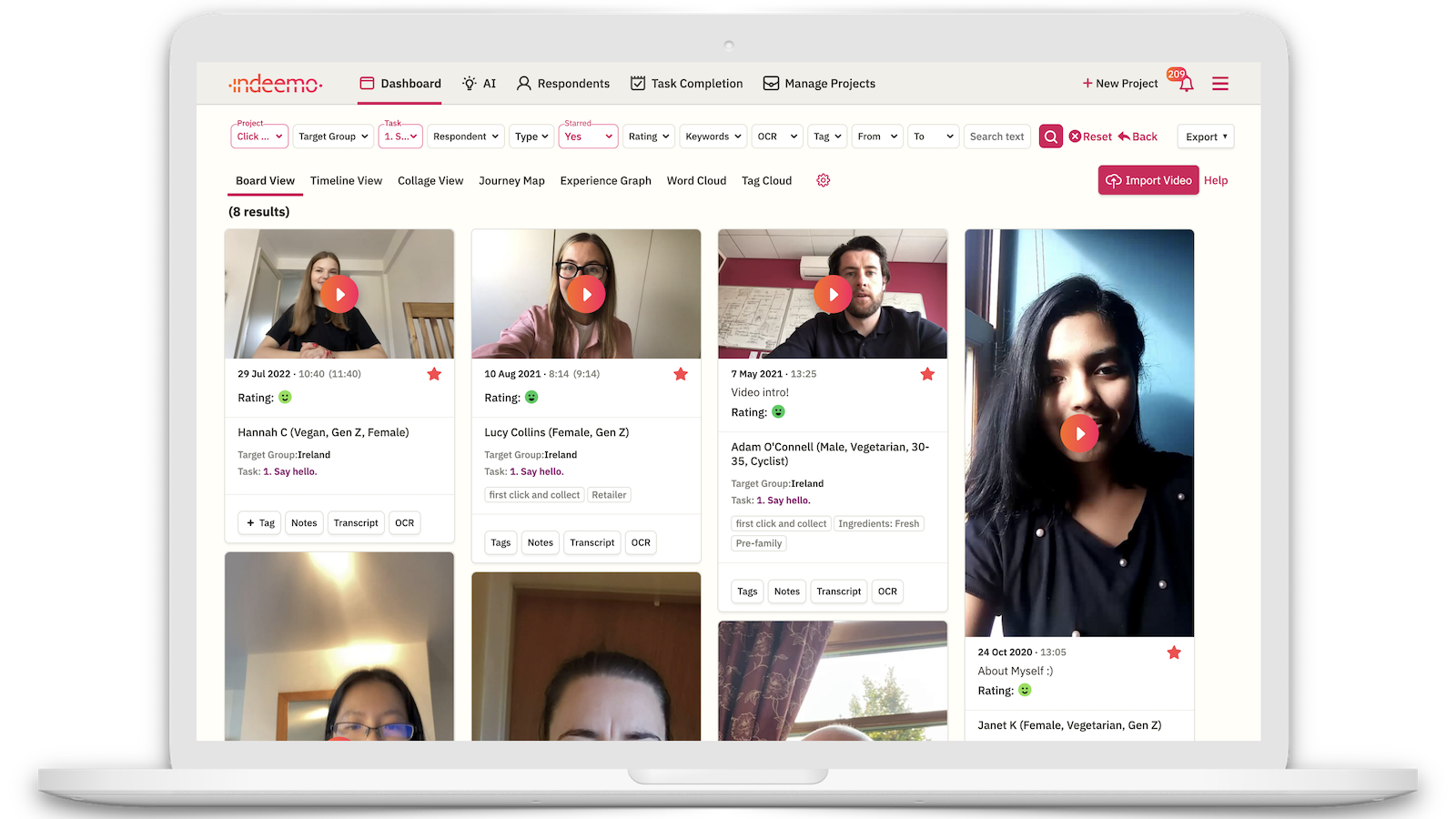Top Five Research Tools to Identify Customers Unmet Needs
Understanding the unmet needs of consumers is essential for any business looking to succeed in today's market. Capturing unmet needs is critical to developing products and services that meet customers' expectations, build loyalty, and drive revenue. According to Forbes, “consumer criticisms, even if they seem outrageous, can provide valuable clues for any business”.
In today's highly competitive market, understanding and addressing the unmet needs of consumers is essential for businesses to stay ahead of the game. In this blog post, we discuss the meaning of unmet needs, the importance of empathy in identifying them, and how to capture and uncover them effectively. We present four powerful tools to uncover unmet needs, including ethnography, journey mapping, diary studies, and iHUTSs (In-Home-Usage-Testing). By recognising the importance of context and customer-centric solutions, organisations can create more effective and profitable products and services.

Additional Capabilities
To help you better understand the Unmet Needs of your Customers, you can also do the following with Indeemo:
• Recruit Participants in hours
Recruit B2C and B2B participants in hours from a panel of 3 million+ Respondents.
• Speed up analysis with Generative AI
Use Generative AI prompts for summarisation, translation, thematic analysis, sentiment analysis etc. and reduce analysis time by at least 40%.
• Analyse Interviews and IDIs
Import your interviews from Zoom, Microsoft Teams or your computer, transcribe them in 27 languages and analyse them fast with Generative AI.
• Analyse Interviews and IDIs
Import your interviews from Zoom, Microsoft Teams or your computer, transcribe them in 27 languages and analyse them fast with Generative AI.
What is meant by Customer and Consumer Unmet Needs?
Unmet needs refer to the wants and desires of consumers that are not currently being fulfilled by existing products or services. These needs are often identified through market research, customer feedback, user research, and they can range from minor inconveniences to major pain points for many customers.
These needs may arise from a variety of sources, such as a lack of features, poor user experience, or high cost.
Identifying and addressing consumer unmet needs is essential for businesses and brands to remain competitive, as it allows them to be innovative, and design solutions that align with key areas of the customer experience.
By addressing unmet needs, businesses can gain a competitive edge in the marketplace, improve brand loyalty, and increase revenue.
Additionally, understanding unmet needs is a crucial component of achieving customer closeness because it enables businesses to identify and address gaps in the market, develop products and services that meet customer demands, and build stronger relationships with their customers based on empathy and trust.
Empathy: the Holy Grail of uncovering “Unarticulated, Unmet Needs”
Empathy is crucial for understanding unmet needs of consumers because it enables researchers to view problems from the perspective of the consumer, and to develop solutions that truly meet their needs. In fact, Microsoft CEO, Satya Nadella claims that empathy is an “existential priority for businesses”.
Source : Nadella Says Children's Challenges Taught Him Empathy by Bloomberg Television Channel on Youtube.
In a 2018 interview with Bloomberg, Nadella discussed the concept of product-market fit and discussed how he built a strong sense of empathy through his private and family life - transferring this to worklife, which has transcended the culture of Microsoft.
Satya Nadella is a champion of empathy and has embedded this in the way Microsoft innovative new products to meet the needs of its global customer-base. Since Nadella became Microsoft CEO in 2014, shares have grown by 600%. For Satya Nadella, he credits much of his success and open leadership style to empathy and empathy building.
“Empathy is not just about feeling the pain of others; it’s also about bringing them the hope and possibilities they deserve.”
Research Methods to Understand Customer Unmet Needs
To stay competitive and relevant, brands must go beyond what customers say and uncover what they truly need - but may not yet articulate. Below are five research methodologies that help reveal unmet needs with depth and precision, especially when empathy and real-world context are critical.
1. Generative Research
Generative research is all about exploration. It uncovers deep-seated needs, motivations, and pain points through open-ended interviews, co-creation sessions, and participatory exercises. This method is particularly valuable in early-stage innovation or when entering new markets.
When to use it:
Defining opportunity spaces
Informing product or service innovation
Understanding emerging behaviours
2. Digital Ethnography
Digital ethnography immerses you in the everyday lives of your customers remotely. By observing behaviours in-context via photos, videos, and mobile diaries, researchers gain a raw, unfiltered view of routines, environments, and emotional triggers.
Why it works:
It captures how people actually behave, not just what they recall in hindsight, making it ideal for identifying latent needs that influence decisions.
3. Customer Journey Mapping
This method visualises the full experience a customer has with your brand or category across touchpoints. It helps identify friction, emotional highs and lows, and key gaps where expectations aren’t being met.
What you uncover:
Moments of frustration
Drop-off points in decision journeys
Opportunities for service or CX innovation
4. Diary Studies
Participants self-document their interactions over several days or weeks, offering longitudinal insights into evolving behaviours, habits, and needs. Think of it as a personal insight journal, filled with real-time data.
Use case highlights:
Tracking brand or product experiences over time
Uncovering routine pain points
Validating emerging needs in context
5. In-Home Usage Tests (iHUTs)
Give customers a product to use in their own space and gather feedback through photos, video, and post-use reflections. These tests simulate real-world conditions and help expose usability issues or unmet expectations that lab tests might miss.
Ideal for:
Product iteration and refinement
Packaging feedback
Validating emotional and functional performance
A Multi Method Approach
Leveraging Findings in Follow-Up Interviews and Focus Groups
The insights gathered from these diverse methods can then be strategically used to inform follow-up interviews and focus groups. For instance, themes identified in diary studies can be explored in greater depth during interviews, while journey mapping can highlight specific stages of the customer experience to probe in focus groups. This approach ensures that every stage of research builds upon the previous, leading to richer, more nuanced findings.
How Indeemo Can Help
Platforms like Indeemo are now equipped to support this integrated research approach seamlessly. Indeemo’s AI video analysis capability, researchers can upload recordings of their follow-up interviews and focus groups directly from platforms like Zoom or Microsoft Teams. This feature complements the data already gathered through initial fieldwork methods mentioned earlier.
What sets Indeemo apart is its ability to transcribe these video imports automatically, readying them for comprehensive data analysis. This saves invaluable time and resources in the research process and ensures that all data, whether from initial ethnographic studies or subsequent interviews, are housed in a single, accessible platform.
Qualitative Data Analysis with Indeemo’s Generative AI
Further enhancing its platform, Indeemo introduces a sophisticated, user-friendly generative AI for qualitative data analysis. Researchers can now delve into their collected data with greater efficiency and precision. Our generative ai tool for data analysis Generative AI capabilities extend to analyzing interview transcripts and in-the-moment video uploads, enabling tasks like sentiment analysis, thematic analysis, and quote extraction. This powerful tool helps researchers to uncover underlying consumer preferences, attitudes, and subtle nuances that might be missed in manual analysis.
With such advancements, Indeemo is not just a tool but a comprehensive research partner, enabling researchers to leverage multi-method approaches effectively. From initial data capture to intricate data analysis, Indeemo’s platform streamlines the research process, allowing researchers to focus on deriving actionable insights that truly resonate with consumers' unmet needs.
Leveraging Generative AI to Uncover Unmet Needs
Generative AI is revolutionising the analysis of qualitative data with its ability to process information at an unparalleled scale and speed. But, can Generative AI be leveraged to uncover unmet customer needs. Generative AI can delve into vast amounts of data—from customer interviews to focus groups—identifying nuanced needs through deep semantic analysis. It should recognise patterns and sentiments, offering businesses insights into the emotions and intentions behind customer feedback. This not only ensures a comprehensive understanding of unmet needs but also highlights emerging trends, providing a competitive edge by anticipating market shifts.
Furthermore, Generative AI enhances the efficiency and effectiveness of qualitative research by automating the initial data analysis stages. This allows human analysts to focus on interpreting complex insights, applying strategic thinking to develop innovative solutions. The adaptive nature of Generative AI, improving with each data interaction, ensures that businesses can continually refine their understanding of customer needs. Thus, integrating Generative AI into qualitative research processes empowers businesses to uncover and address unmet customer needs more effectively, fostering innovation and securing a competitive advantage in the dynamic market landscape.
Researching unmet needs is critical for innovation
In conclusion, the journey to uncover and address the unmet needs of consumers is pivotal for businesses aiming to stay competitive and drive innovation. Empathy remains a fundamental element in this quest, guiding the development of solutions that are genuinely aligned with customer needs. However, the path to understanding these needs has evolved, demanding a more nuanced and integrated approach to research.
By employing a multi-method research strategy that combines digital ethnography, journey mapping, generative research, diary studies, and iHUTs, businesses can gain a multifaceted understanding of their consumers. This comprehensive approach not only highlights the importance of context in consumer research but also ensures that every perspective and nuance is captured.
Platforms like Indeemo are at the forefront of this evolution, offering advanced capabilities such as video import and generative AI for qualitative data analysis. These tools empower researchers to seamlessly integrate various data forms, from initial fieldwork to in-depth interviews and focus groups, all within a single platform. The automatic transcription and sophisticated AI-driven analysis enable a deeper dive into the sentiments, preferences, and attitudes of consumers, uncovering the subtleties that define their unmet needs.
As businesses navigate the complexities of the modern market, the ability to effectively combine multiple research methods and leverage cutting-edge platforms like Indeemo will be key to developing customer-centric products and services. This integrated approach not only fosters a deeper understanding of consumer needs but also propels businesses toward more effective, empathetic, and innovative solutions.
Let us support your unmet needs research
Indeemo processes your personal data in order to respond to your query and provide you with information about our products and services. Please see our Privacy Statement for further information.
If the above approach resonates with your research objectives, please get in touch and we can set up a call with one of our Strategists to discuss your own specific research requirements when it comes to understanding the unmet needs of consumers.





